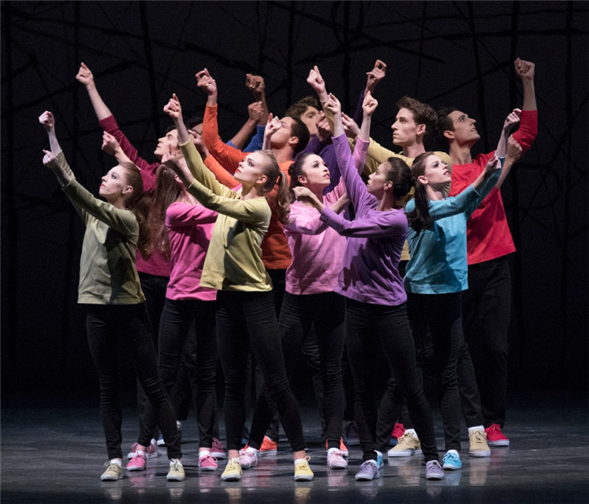Translate Page

NYCB presents sneaker ballets by Jerome Robbins and Justin Peck
---
When Justin Peck's The Times Are Racing premiered two years ago at New York City Ballet, it offered an exciting jolt. There wasn't a pointe shoe or ballet slipper in sight. Instead, the dancers wore sneakers and outfits (designed by Humberto Leon) you might see young folks wearing on the street.
But beyond that casual contemporary aesthetic, it was the unpredictable movement and the dancers' fierce energy that got people's attention. Set to propulsive electronic tracks off Dan Deacon's America album, Peck's explosive ballet seemed to reflect the mood of millennials.
Almost 60 years earlier, Jerome Robbins had put a ballet company in sneakers for a work that connected with that era's youth. His N.Y. Export: Opus Jazz evoked the rebelliousness of a generation frustrated by expectations, striving to break free and searching for a unique voice.
Both of these pieces are part of New York City Ballet's winter season at Lincoln Center, which continues through March 3 (with Peck's ballet returning for an encore run in the spring). They are elegantly structured creations of master craftsmen that also allow the dancers to explore movement with a dynamic sense of freedom.
"You're always a character; you're always digging deep to challenge yourself," says ballet master Craig Hall, a former NYCB soloist who previously danced a leading role in Opus Jazz and now helps rehearse Peck's ballet. "Sometimes you don't think you have something in you, and then if you allow it, you can surprise yourself and you can evolve."
Fresh off his Broadway triumph West Side Story, Robbins created Opus Jazz in 1958 for his short-lived touring ensemble Ballets: U.S.A. Although its jazz-inflected score by Robert Prince and aura of alienation were rooted in the period, it continued to be performed by other troupes, notably Joffrey Ballet in the 1970s. In 2005, the work became part of NYCB's repertory, and the dancers learned the choreography from Edward Verso, who had performed the piece with Ballets: U.S.A.
"It was a great experience because we had time to work on it," recalls Hall. "We really got to talk with him about his connection with the story and with Ballets: U.S.A. He painted a vivid picture. It was nice to get a person who came in and taught us not just the steps, but the feeling of what was happening in the world at the time, what it was like to be a kid and to be heard through your movement." Two of NYCB's original Opus Jazz soloists loved the piece so much, they ended up producing a movie version, shot on location throughout New York City.
For both works, sneakers were obligatory for every rehearsal. "Wearing ballet slippers, you feel very pulled up and confined in a way," Hall explains. "With sneakers, you're more grounded into the earth. Your whole body placement is a little bit lower. It was essential for us to always do them in sneakers."
In addition to choreographing The Times Are Racing, Peck performs in both ballets. While he's expressed admiration for Opus Jazz in the past, there are no specific allusions to it in his work. Yet Hall senses that the two dances share something, despite having been created in wildly different eras.
"Robbins has clearly been an inspiration," says Hall about The Times Are Racing. "You can see it in the movement quality and the sense of community. It's about being a unit. The dancers are all this big ball of energy and confusion, and the minute you're not attached to that, then you are a loner, and you won't be as powerful as the mass of people you're connected to. It's that quality of nothing else matters, only the music. You really have to let yourself go. Stop trying to make the shapes perfect, because it's not about perfect shapes. It's about movement and letting the audience see you lose control."
---
Susan Reiter regularly covers dance for TDF Stages.
Top image: NYCB in N.Y. Export: Opus Jazz. Photos by Paul Kolnik.
TDF MEMBERS: Go here to browse our latest discounts for dance, theatre and concerts.